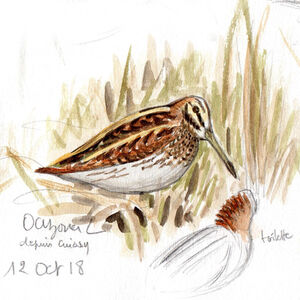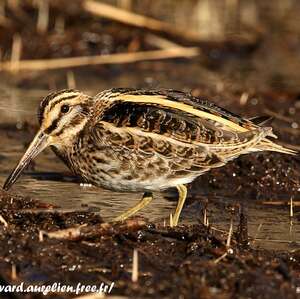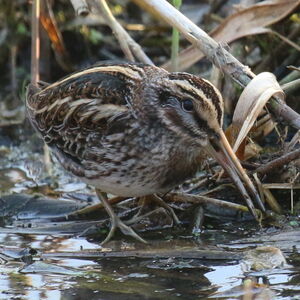Jack Snipe
Lymnocryptes minimus - Bécassine sourde
Identification
Jack Snipe is the smallest of the snipes. It is barely larger than a meadow lark. The male is larger and heavier, sometimes twice as much in weight. When it takes off, you can recognize it by its small size and obviously its snipe silhouette. It is usually during flight that it can be observed. It is very rare to see it perched in its environment without specific stakes because it almost never shows itself in the open during the day.
It is difficult to observe it in flight as we mostly see it from behind and for a brief moment. Let's summarize the recognizable criteria: small size - flight much less energetic than that of the Common Snipe and silent - a Common Snipe type of cry when taking off but less powerful - a short bill, a little bit longer than the head - a pointed tail without white - some whiteness on the rear of the wings and, if we are lucky, some pale bands on the dark colour of its upper parts.
If we are lucky enough to see it perched, look no further, it is unique in its own way. What strikes first from that perspective is its homochrome colour and mimicry of the plumage blending into the sombre mud and linear, dry and green plants and pastures of its environment in which it stands still. A picture from the gallery is particularly speaking to this matter, it is the vipa97 221. It also shows us the shortness of the bill (around 1.3 times the head) and a specific character, the absence of a pale mid stripe on the crown (2 stripes on the sides). The upper parts are very dark, a mix of black being the most dominant, fawn, chamois and some whitish liserés. The dark areas reflect the green or violet light. Four bright longitudinal lines of straw colour stand out on this dark background: 2 on the back of the upper coat to the tail and two laterals on the scapulars, extending on the tertiary remiges.That's enough for identification. For the rest, just look at the images provided. The sexes are similar, except for size. The juvenile looks like the adult and the distinction can only be made by hand.
Subspecific information monotypic species
Foreign names
- Bécassine sourde,
- Agachadiza chica,
- narceja-galega,
- Zwergschnepfe,
- kis sárszalonka,
- Bokje,
- Frullino,
- dvärgbeckasin,
- Kvartbekkasin,
- močiarnička tichá,
- slučka malá,
- Enkeltbekkasin,
- jänkäkurppa,
- becadell sord,
- Dvergsnípa,
- bekasik,
- vistilbe,
- puklež,
- Гаршнеп,
- コシギ,
- 姬鹬,
- นกปากซ่อมเล็ก,
- 小鷸 〔小田鷸,姬鷸〕,
Voice song and call
At flight, it emits a etch reminiscent of the Jack Snipe, but less powerful and therefore less audible. One can also hear a haa with a tone of a wader. The song is very particular. It evokes a cuckoo-like song. It begins with the repetition of a simple note ciou cou cou cou cou... followed by a more complex phrase resembling a distant gallop coutcoutouc coutcoutouc coutcoutouc.... It is emitted during the nuptial flight at dusk, sometimes during the day.
Habitat
The Jack Snipe breeds in the north of the continent in marshes, floodplains and bogs, in wooded tundra and in taiga.
In winter, it is found in various brackish and fresh water habitats, often a mosaic of wet and waterlogged mudflats with stands of vegetation. During cold periods, it readily retires along waterways or in water meadows fed by artesian springs.
On passage, it gladly stops in small water points of ludicrous size that it scrupulously exploits between tufts of grasses or sedges.
Behaviour character trait
Unlike their cousins the common snipes which are individualists, Jack Snipes like company. But the Jack Snipe is perhaps the least gregarious of them all.
Still, in places of limited extension on the migration paths, one can find some individuals close to one another.Its main characteristic is its extreme discretion. In case of danger, it flattens itself against the ground, trusting in the camouflage of its plumage in a plant context. It can be approached at very short distances, less than one meter, but the slightest abrupt movement provokes a surprise flight often accompanied by a brief cry. It moves away with a slow and hesitant flight but quickly seeks the shelter of vegetation and does not hesitate to rest nearby if there are other favourable places.
The first migrants arrive in our temperate regions around the middle of October. Many of them settle here, at least until the cold weather drives them away. During the pre-nuptial migration, Jack Snipes are quite eager to reach the northern territories, they stay in one place less long and so are less visible.
Flight
Dietfeeding habits
When the Jack Snipe feeds, it moves its body up and down with agility like a mechanical toy. It is said to "pump". This movement must provoke a reaction from potential prey, which are thus detected. It rummages in the soil, especially looking for worms; hence the importance of a soft soil. It also consumes insects and their larvae, diptera among others, small molluscs etc. It sometimes completes its diet with vegetarian items such as seeds.
Reproduction nesting
The breeding period runs from May to early September. The species is probably monogamous. The male sings in demonstrative flight, typically at dawn and dusk, but sometimes throughout the day.
Pairs often nest on floating peat rafts, but sometimes on drier ground among bushes. The nest cup is lined with various leaves which will receive the 4 Jack Snipe eggs of the laying, sometimes only 3, brown-olive to dark brown with dark brown and sepia spots. Incubation of 21 to 24 days is probably carried out by both partners. The chicks are quite colourful and are still covered by their parents for the first few days, especially if the weather requires it. Later, they will accompany the male, while the female is probably trying to recover physiologically on her own. They will fly at the age of around 3 weeks, gaining their independence.Geographic range
The Jack Snipe breeds from northern Scandinavia to the far east of Russia in boreal and sub-arctic latitudes. A few known nesting areas are further south in Europe, to the south of the Scandinavian peninsula and in the Baltic countries.
It winters in the temperate western Europe, around the Mediterranean, and locally from Minor Asia in the south-east of China, down to Ceylon in the south. It can be found in a large sub-Saharan band in Africa. It is therefore a great migrant.
Threats - protection
Sources of information
- IOC World Bird List (v15.1), Gill, F and D Donsker (Eds). 2025-12-07.
- Limicoles, gangas et pigeons d'Europe, Paul Géroudet (mise à jour Georges Olioso)
- Shorebirds, an identification guide to the waders of the world, Peter Hayman, John Marchant Tony Prater
- Birds of the World, The Cornell Lab of Ornithology
- xeno-canto, Sharing bird sounds from around the world,
Other sources of interest
 Specification sheet created on
26/07/2023 by Jean François
Specification sheet created on
26/07/2023 by Jean FrançoisTranslation by AI Oiseaux.net
© 1996-2026 Oiseaux.net
- Accipitriformes
- Aegotheliformes
- Anseriformes
- Apodiformes
- Apterygiformes
- Bucerotiformes
- Caprimulgiformes
- Cariamiformes
- Casuariiformes
- Charadriiformes
- Ciconiiformes
- Coliiformes
- Columbiformes
- Coraciiformes
- Cuculiformes
- Eurypygiformes
- Falconiformes
- Galliformes
- Gaviiformes
- Gruiformes
- Leptosomiformes
- Mesitornithiformes
- Musophagiformes
- Nyctibiiformes
- Opisthocomiformes
- Otidiformes
- Passeriformes
- Pelecaniformes
- Phaethontiformes
- Phoenicopteriformes
- Piciformes
- Podargiformes
- Podicipediformes
- Procellariiformes
- Psittaciformes
- Pterocliformes
- Rheiformes
- Sphenisciformes
- Steatornithiformes
- Strigiformes
- Struthioniformes
- Suliformes
- Tinamiformes
- Trogoniformes




























